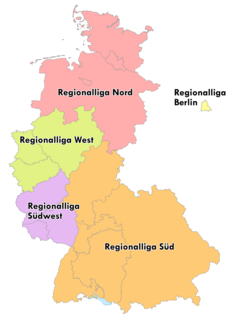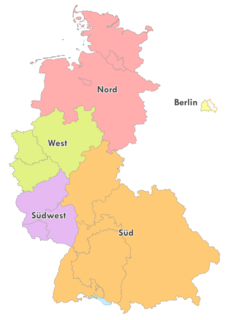Overview
1947–1963
The league was formed as Landesliga Niedersachsen in 1947, operating with four divisions in variable strength, all up with 42 clubs. The four regional divisions were named after the capital city of the district, being Hanover, Hildesheim, Braunschweig and Osnabrück. Additionally, some clubs from Lower Saxony also played in the Amateurliga Bremen, a trend that continues to a lesser degree even today. The state of Lower Saxony had only recently then been formed in the British occupation zone and the status of the Free Hanseatic City of Bremen as an independent German state had not been fully confirmed yet.

Upon defeat of Nazi Germany in World War II, the victorious Allies asserted joint authority and sovereignty over 'Germany as a whole', defined as all territories of the former German Reich west of the Oder–Neisse line, having declared the destruction of Nazi Germany at the death of Adolf Hitler. The four powers divided 'Germany as a whole' into four occupation zones for administrative purposes, under the United States, United Kingdom, France and the Soviet Union respectively; creating what became collectively known as Allied-occupied Germany. This division was ratified at the Potsdam Conference. The four zones were as agreed in February 1945 by the United States, United Kingdom and Soviet Union meeting at the Yalta Conference; setting aside an earlier division into three zones proposed by the London Protocol.

Bremen, officially the Free Hanseatic City of Bremen, is the smallest and least populous of Germany's 16 states. It is informally called Land Bremen, although this is sometimes used in official contexts. The state consists of the city of Bremen as well as the small exclave of Bremerhaven in Northern Germany, surrounded by the larger state of Lower Saxony.
From the start, the Landesliga Niedersachsen was a feeder league to the Oberliga Nord which its champion had the option of promotion to. Promotion had to be archived through a play-off with teams from the Amateurligen of Bremen, Hamburg and Schleswig-Holstein. As such, the league was the second tier of the northern German league system.
The Oberliga Nord was the highest level of the German football league system in the north of Germany from 1947 until the formation of the Bundesliga in 1963. It covered the states of Lower Saxony, Bremen, Hamburg and Schleswig-Holstein.

The Bremen-Liga, sometimes also referred to as Oberliga Bremen, is the fifth tier of the German football league system and the highest league in the German state Free Hanseatic City of Bremen. It is one of fourteen Oberligas in German football, the fifth tier of the German football league system.

The Oberliga Hamburg, sometimes referred to as Hamburg-Liga, is the highest league in the German state of Hamburg, incorporating some of its surrounding districts. It is one of fourteen Oberligen in German football, the fifth tier of the German football league system.
In 1949, the four Landesligen were disbanded in favor of the two new Amateuroberligen, the Amateuroberliga Niedersachsen-West and the Amateuroberliga Niedersachsen-Ost. The western division started with sixteen, the eastern with eighteen clubs. The majority of clubs previously playing in the Bremen leagues also returned to the Lower Saxony league system. Below the Amateuroberligen, eight Amateurligen were established. This system remained as such unchanged until 1964.
The two leagues continued to exchange clubs to balance out promotion and relegation but did not play out a Niedersachsen champion as such since promotion was decided between these two leagues and the other three northern German leagues. Especially the clubs from Hanover were frequently transferred between divisions.

Hanover or Hannover is the capital and largest city of the German state of Lower Saxony. Its 535,061 (2017) inhabitants make it the thirteenth-largest city of Germany, as well as the third-largest city of Northern Germany after Hamburg and Bremen. The city lies at the confluence of the River Leine and its tributary Ihme, in the south of the North German Plain, and is the largest city of the Hannover–Braunschweig–Göttingen–Wolfsburg Metropolitan Region. It is the fifth-largest city in the Low German dialect area after Hamburg, Dortmund, Essen, and Bremen.
After the first couple of seasons went with ever-changing club numbers in the two leagues, reaching a peak of twenty, by 1954 both leagues had arrived at sixteen clubs each, which they maintained for the most of the coming seasons.
1963-1974
In 1963, with the introduction of the Bundesliga, the disbanding of the Oberliga Nord and the formation of the Regionalliga Nord, the leagues fell to tier three, but initially remained unchanged otherwise. The champions of the Niedersachsen leagues continued to have to play-off for promotion, now to the Regionalliga, with the same opposition as before.

The Bundesliga is a professional association football league in Germany and the football league with the highest average stadium attendance worldwide. At the top of the German football league system, the Bundesliga is Germany's primary football competition. The Bundesliga comprises 18 teams and operates on a system of promotion and relegation with the 2. Bundesliga. Seasons run from August to May. Most games are played on Saturdays and Sundays, with a few games played on weekdays. All of the Bundesliga clubs qualify for the DFB-Pokal. The winner of the Bundesliga qualifies for the DFL-Supercup.
The year 1964 saw the creation of a single-division highest league for Niedersachsen. Eight clubs from the western group, seven from the eastern group, one team from the Regionalliga and two promoted teams made up the new Amateurliga Niedersachsen. Promotion however still had to be archived through a promotion round with the other northern German champions.
Below the Amateurliga, four new Verbandsligen were established, North, South, East and West, with their champions directly promoted and four clubs relegated from the eighteen-team Amateurliga.
The Verbandsliga is usually a tier-six football league in the German football league system, covering the area of a Bundesland or a regional part of such Bundesland.
The late 1960s and early 1970s saw the oddity of fourth and fifth placed teams being promoted. The reasons for this were the fact that Lower Saxony, as the strongest association in northern Germany was permitted to send more than one team to the promotion round and the high finishes of reserve teams of the likes of Hannover 96, Arminia Hannover and Eintracht Braunschweig in the league, which were ineligible to enter the promotion rounds.
The league strength for most of these season stood at sixteen clubs.
1974–1994
After the 1973–74 season, the Regionalliga Nord was disbanded in favor of the 2nd Bundesliga Nord. The new Oberliga Nord was now introduced in northern Germany, as the third tier of the league system, below the 2nd Bundesliga. This meant for the Amateurliga a slip to tier four. The top three teams of the league were however promoted to the new Oberliga and the Amateurliga was renamed Landesliga Niedersachsen. The system for promotion from the Landesliga remained mostly unchanged and the league continued to operate on sixteen clubs.
For the first time, reserve teams were also eligible for promotion from the Niedersachsen league and Eintracht Braunschweig II became the first team to do so in 1975.
In 1979, the league changed its name once more, now becoming the Verbandsliga Niedersachsen, but remaining unchanged otherwise.
1994–2008
In 1994, the Regionalliga Nord was re-established, now as the third tier of the league system. The Oberliga Nord was in turn replaced by two parallel Oberligen, Niedersachsen/Bremen and Hamburg/Schleswig-Holstein. For the Verbandsliga Niedersachsen, this meant a further slip, now to tier five, and a split to two separate divisions again, but also, for the first time in its history, direct promotion for the league champions.
While the first and third placed team from the 1993-94 season gained entry to the new Regionalliga, the other twelve clubs of the top-fourteen were promoted to the Oberliga Niedersachsen/Bremen. Only the bottom five teams of the field of nineteen of that season actually remained in the Verbandsligen.
The first season of the new separated leagues saw a strong imbalance of clubs, West operated on sixteen, East on twenty-one teams. The year after, both run on a strength of sixteen.
The 1999–2000 season saw another league system change with the reduction of numbers of Regionalligen, this however had only one effect on the Verbandsligen, no direct promotion was available this year.
In 2004, it was decided to restore the Oberliga Nord in favor of the two separate Oberligen.
2008–2010
At the end of the 2007–08 season, the new 3. Liga was established and the Oberliga Nord disbanded, again. The four northern German states were then the only region without an Oberliga and the five Verbandsligen sat right below the Regionalliga Nord, parallel to the two NOFV-Oberligas. At the end of the 2007-08 season, the five winners of the northern Verbandsligen played with the sixth placed team from the Oberliga Nord for one last spot in the Regionalliga. [2] In the following seasons, promotion for the Niedersachsenliga winners was only available through a decider between the two champions. These two teams competed for one promotion spot to the Regionalliga. The Niedersachsen-Liga however maintained their status as tier five leagues and accordingly was renamed Oberliga Niedersachsen.
2010 onwards
The 2009–10 season functioned as a qualifying stage for the new single-division Niedersachsenliga, which kick-off in 2010. While the Lower Saxony champion was promoted to the Regionalliga, as in the previous season, the other fifteen teams placed one to eight in the two leagues were directly qualify for the new league. The four teams placed ninth and tenth took part in a qualifying round with the four Bezirksoberliga champions. In two groups of four, the top-two of each group also qualified for the new league. The teams placed eleventh or lower in the Oberligen in 2009–10 were automatically relegated. [1]
The new single-division Niedersachsenliga consisted of 20 clubs in its first season and then 18 thereafter, also fluctuation due to relegation/promotion to and from the Regionalliga are possible.
At the end of the 2011–12 season, the top four clubs, being the Goslarer SC, BV Cloppenburg, VfB Oldenburg and BSV Schwarz-Weiß Rehden, were directly promoted to the Regionalliga Nord while the sixth placed club, SV Holthausen/Biene, unsuccessfully entered a promotion playoff with the runners-up from the Oberliga Hamburg and Schleswig-Holstein-Liga. Fifth placed VfL Osnabrück II was ineligible for promotion to the Regionalliga as it is the reserve side of a 3. Liga team.















